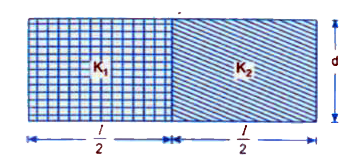
Two identical dielectric slabs, A and B, are placed symmetrically between the plates X and Y of charged parallel-plate capacitor. The electric intensity has magnitudes E1/E2 and E3 at the points 1,2 and 3
E1>E2>E3
E1=E3<E2
E1=E3>E2
E1=E2=E3
The correct Answer is:D
Step by step video, text & image solution for Two identical dielectric slabs, A and B, are placed symmetrically between the plates X and Y of charged parallel-plate capacitor. The electric intensity has magnitudes E_(1)//E_(2) and E_(3) at the points 1, 2 and 3 by Physics experts to help you in doubts & scoring excellent marks in Class 12 exams.
Updated on:21/07/2023Topper's Solved these Questions
Similar Questions
Two dielectric slabs of dielectric constants K1andK2 are filled in between the two plates, each of area A, of the parallel plate capacitor as shown in the figure. Find the net capacitance of the capacitor.

View SolutionA parallel plate capacitor has plates of area 0.080m2 and a separation of 1.2 cm . A battery charges the plates to a potential difference of 120V and is then disconnected . A dielectric slap of thickness 4.0mm and dielectric constant 4.8 is then placed symmetrically between the plates (a) What is the capacitance with the slab in place ? What is the free charge q (c) before and (d) after the slap is inserted ? What is the magnitude of the electric field (e) in the space between the plates and dielectric and (f) in the electric itself? (g) with the slab in place, what is the potential difference across teh plates (h) How much external work is involved in inserting the slab?
View Solution
Knowledge Check
A dielectric slab is placed between the plates of a parallel plate capacitor. Its capacitance
Abecomes zeroBremains the sameCdecreasesDincreasesA dielectric slab fills the space between the plates of a parallel-plate capacitor. The magnitude of the bound charge on the slab is 75%ofthemagnitudeoftheeechar≥ontheplates.The∩acitanceis480mufandthemaxiμmchar≥tˆcanbes→redonthe∩aci→ris240varepsilon_(0)L^(2) E_(max)whereE_(max) is the breakdown field.
Athe dielectric constant for the dielectric slab is 4Bwithout the dielectric, the capacitance of the capacitor would be 360μFCthe plate area is 60L2DIf the dielectric slab is having the same area as the capacitor plate but the width half that of the capacitor, the capacitance would be 192μFA parallel -plate capacitor is connected to a cell. A sheet of dielectric and a metal sheet are now introduced between the plates of the capacitor, parallel to these plates. The electric intensity between the positive plate of the capcitor and the metal sheet is E2, and between the metal sheet and the negatilve plate is E3. Then
AE1=E2=E3BE1=E2≠E3CE1≠E2=E3DE1≠E2≠E3
Two protons A and B are placed in between the two plates of a parallel plate capacitor charged to a potential difference V as shown in the figure. The forces on the two protons are identical.

View Solution
A parallel- plate capacitor is charged from a cell and then isolated from it. A dielectric slab of dielectric constant K is now introduced in the region between the plated, filling half of it. The electric intensity in the diaelectric is E1 and that in air is E2.
View SolutionA dielectric slab fills the space between the square plates of a parallel-plate capacitor. The side of each plate of the capacitor is L. The magnitude of the bound charges on the slab is 75% of the magnitude of the free charge on the plates. The capacitance is 480μF and the maximum charge that can be stored on the capacitor is 240ε0L2Emax, where Emax is the breakdown strength of the medium:
View SolutionElectric potential difference between the positive plate and halfway point between the two parallel plates of a fully charged capacitor is
View SolutionTwo thin dielectric slabs of dielectric constants K1 and K2(K1<K2) are inserted between plates of a parallel plate capacitor, as shown in the figure. The variation of electric field E between the plates with distance d as measured from plate P is correctly shown by

View Solution
